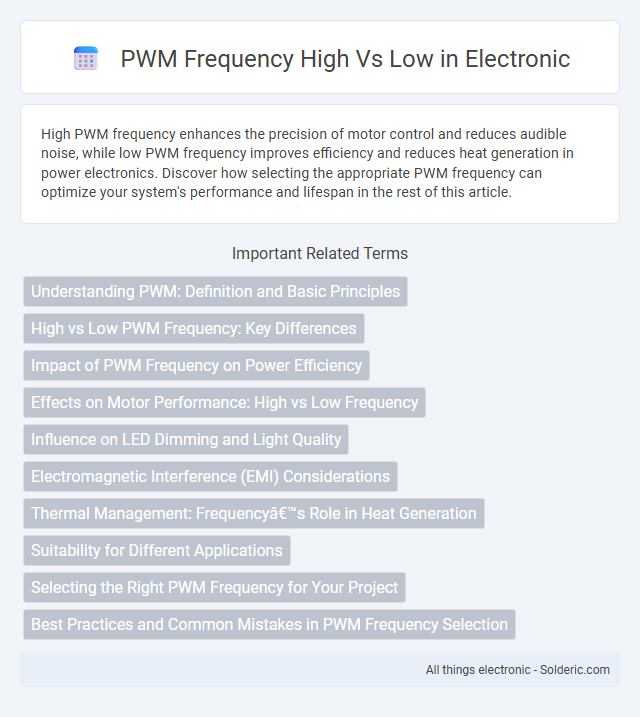High PWM frequency enhances the precision of motor control and reduces audible noise, while low PWM frequency improves efficiency and reduces heat generation in power electronics. Discover how selecting the appropriate PWM frequency can optimize your system's performance and lifespan in the rest of this article.
Comparison Table
| Aspect | High PWM Frequency | Low PWM Frequency |
|---|---|---|
| Switching Noise | Lower audible noise, higher electromagnetic interference (EMI) | Higher audible noise, lower EMI |
| Heat Dissipation | Increased switching losses, more heat generated | Reduced switching losses, less heat generated |
| Output Signal Quality | Smoother output, less ripple | More ripple and potential signal distortion |
| Efficiency | Generally lower due to switching losses | Generally higher efficiency |
| Response Time | Faster response to control changes | Slower response to control changes |
| Applications | LED dimming, motor control, audio amplification | Power supplies, heating elements, simple motor drives |
Understanding PWM: Definition and Basic Principles
PWM (Pulse Width Modulation) frequency determines how often the signal switches between on and off states per second, impacting the smoothness and responsiveness of devices like motors and LEDs. High PWM frequency provides finer control and reduces audible noise by increasing the switching rate, ideal for applications requiring precision. Low PWM frequency reduces switching losses and electromagnetic interference, making it suitable for power-efficient systems where less frequent control updates suffice.
High vs Low PWM Frequency: Key Differences
High PWM frequency offers smoother output signals and reduced audible noise, making it ideal for applications like motor control and audio amplification. Low PWM frequency can lead to increased ripple and audible buzzing but provides easier implementation with less switching loss in power electronics. Your choice of PWM frequency impacts efficiency, thermal management, and the quality of the controlled signal, depending on the specific application requirements.
Impact of PWM Frequency on Power Efficiency
High PWM frequency reduces switching losses and electromagnetic interference, improving power efficiency in sensitive electronic devices. Low PWM frequency minimizes switching frequency-related losses but can cause increased voltage ripple, affecting overall performance and efficiency. Your choice of PWM frequency directly influences the balance between power efficiency and signal quality in your application.
Effects on Motor Performance: High vs Low Frequency
High PWM frequency provides smoother motor operation by reducing audible noise and improving torque precision, which enhances overall motor performance. Low PWM frequency may cause increased vibration and noise due to the motor's coils experiencing sudden current changes, potentially reducing the motor's efficiency and lifespan. Your motor control system benefits from choosing an optimal frequency that balances switching losses and electromagnetic interference for enhanced performance.
Influence on LED Dimming and Light Quality
High PWM frequency reduces visible flicker in LED dimming, resulting in smoother light transitions and improved light quality. Low PWM frequency can cause noticeable flickering, which may lead to eye strain and diminished visual comfort. Optimizing PWM frequency enhances LED performance by providing consistent brightness and stable color rendering.
Electromagnetic Interference (EMI) Considerations
High PWM frequency reduces audible noise but increases electromagnetic interference (EMI) due to rapid switching transitions, requiring enhanced filtering and shielding. Low PWM frequency minimizes EMI emissions but can cause audible noise and less efficient power delivery. Proper frequency selection balances EMI mitigation with system performance by optimizing switching speed and filter design.
Thermal Management: Frequency’s Role in Heat Generation
Higher PWM frequencies generally reduce audible noise and enable finer control but increase switching losses in power electronics, leading to greater heat generation and more demanding thermal management. Lower PWM frequencies decrease switching losses and heat but may cause increased electromagnetic interference (EMI) and less precise control. Effective thermal management in high-frequency PWM applications requires enhanced cooling solutions and high-quality components to maintain reliability and performance.
Suitability for Different Applications
High PWM frequency is ideal for applications requiring smooth motor control and minimal audible noise, such as drones and precision robotics. Low PWM frequency suits power electronics and heating elements where switching losses and thermal management are prioritized over noise reduction. Your choice of PWM frequency should align with the specific performance and efficiency demands of your application.
Selecting the Right PWM Frequency for Your Project
Selecting the right PWM frequency depends on your project's specific requirements, such as the type of load and desired control precision. High PWM frequencies reduce audible noise and improve smoothness in motor control but increase switching losses and heat generation. Low PWM frequencies are more efficient for power delivery and reduce stress on components but may cause vibration or audible buzzing in certain applications.
Best Practices and Common Mistakes in PWM Frequency Selection
Selecting the appropriate PWM frequency is critical to optimizing system performance and efficiency, with high frequencies reducing audible noise and improving motor smoothness but increasing switching losses and electromagnetic interference. Best practices involve balancing frequency to match the load characteristics, such as using lower frequencies for inductive loads to minimize heat dissipation and higher frequencies for sensitive electronics to achieve finer control. Avoid common mistakes like choosing excessively high frequencies that cause overheating or too low frequencies that produce audible noise, ensuring your PWM settings align with your device's operational requirements.
PWM frequency high vs low Infographic

 solderic.com
solderic.com